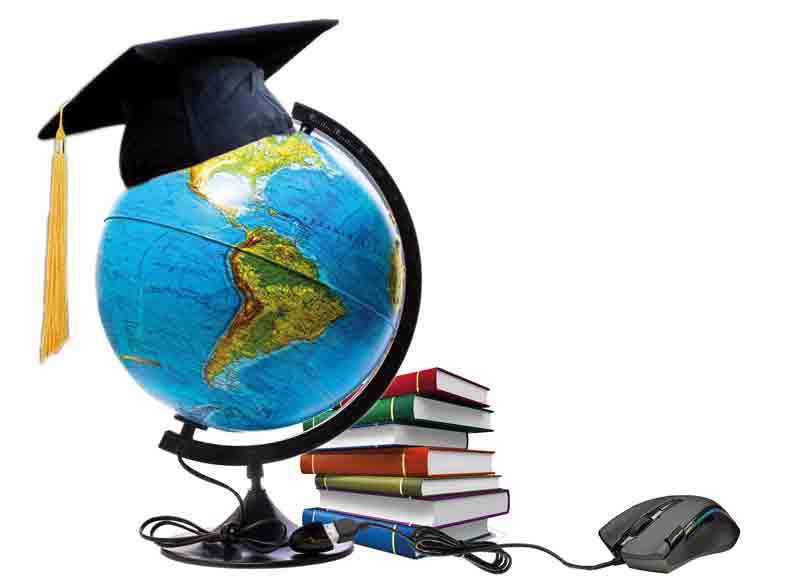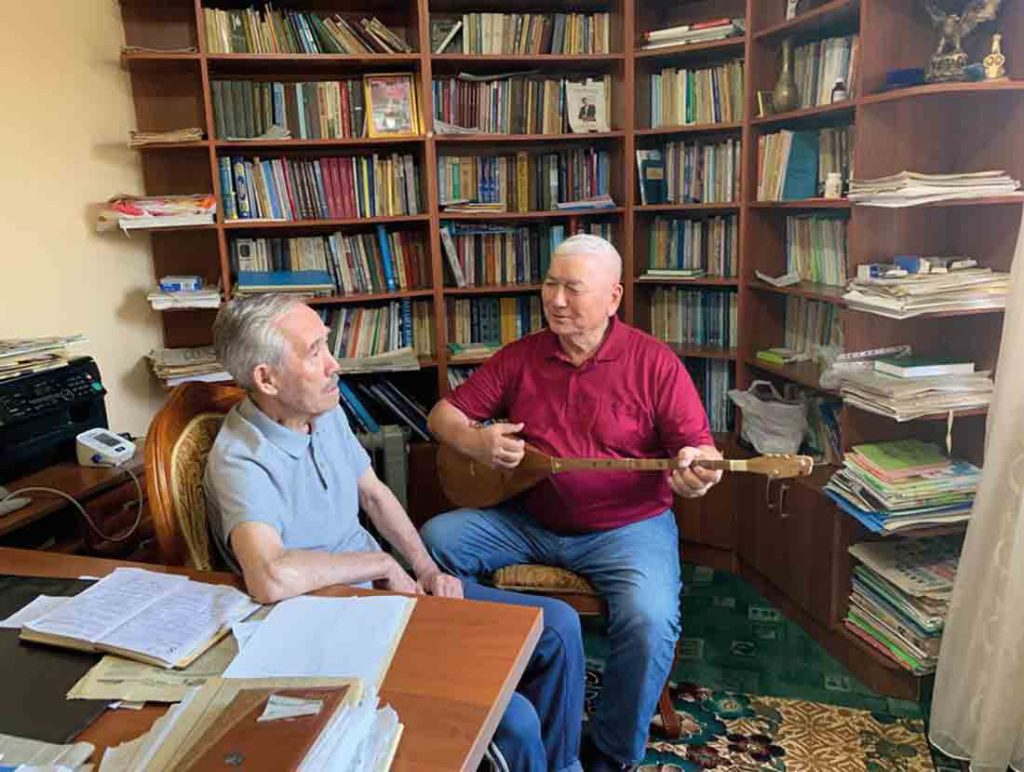The author discusses the effectiveness of the introduction of Information and Communication Technologies (ICT) into pedagogical practice. The purpose of distance learning is to provide students with the online opportunity to master programs in institutions of higher, secondary and vocational education. She argues the wide-spread opinion that the use of ICT generates more problems than it solves.
Problems of Application of Distance Learning in a Technical University

In accordance with the Address of the President of the Republic of Kazakhstan Nursultan Nazarbayev to the people of Kazakhstan “New Decade –New Economic Recovery – New Opportunities of Kazakhstan”, technical and vocational education should be strictly interrelated with the needs of the economy. At the Congress of Entrepreneurs, it was pointed out that today both the state and entrepreneurship are interested in high-class professionals. Therefore, it is necessary to develop human resources, expand partnership in personnel training, and support vocational schools, colleges and universities. [1]
The problem is that the quality of vocational training of college graduates should be strictly interrelated with the needs of the modern economy, which actualizes the partnership of educational organizations with employers, social partners and business community. And this process largely depends on the interactivity and mobility of interaction, which is impossible without the informatisation of vocational education. [2]
However, the effectiveness of this process is due not only to the degree of introduction of Information and Communication Technologies (ICT) into pedagogical practice, but also to the degree of scientific and theoretical understanding of the methodology of their multi-level interaction. Studies have shown that for distance learning, as well as for traditional education, five general didactic teaching methods developed by Isaak Yakovlevich Lerner (1917–1996) are applicable, namely: information-receptive, reproductive, problem presentation, heuristic, and research. They cover the aggregate of pedagogical acts of interaction between the teacher and students. The purpose of distance learning is to provide students directly at the place of residence or their temporary stay with the opportunity to master the basic and additional professional educational programs of higher and secondary vocational education, respectively, in educational institutions of higher, secondary and additional vocational education .[8]
The content of training can be defined as a pedagogical model of a social order; the learning process, methods and organizational forms of its implementation are determined by its content. When selecting content for distance learning, it is advisable to use general principles and recommendations. At the same time, it is necessary to take into account additional restrictions on the object (subject) of training, which may be located at a great distance, and (or) have a special time schedule of vital activity, and (or) the physiological impossibility of learning traditionally and other reasons. Besides, it should be taken into account the fact that distance learning does not allow training of specialists in all specialties. The content of distance learning can be guided by a list of areas of training specialists and specialties in which obtaining higher professional education in correspondence form or in the form of an external course is not allowed.
The theory of information interaction is represented by the following home and foreign scientists: G.K. Nurgalieva [6], I.V. Robert [7], D.I. Abdraimov, E.Y. Bidaibekov, V.V. Grinshkun, G. Kamalova [3], D.M. Dzhusubalieva [6], Zh.A. Makatova, A.I. Tazhigulova, G.S. Kudebaeva [6], etc. Irena Robert analysed information regarding interaction on the basis of modern information and communication technologies, the conditions for the formation and functioning of the information and communication subject to environment, the implementation of various types of educational activities accomplished in it. She has developed didactic principles of learning in the context of realizing the capabilities of multimedia, telecommunications’ and “virtual reality” technologies.[7]
The state of scientific evaluation of the problem of effective remote interaction, affecting the effectiveness of the educational process, shows that this problem is being studied in different aspects: philosophical, sociological, cultural, psychological, and pedagogical. Such an approach, in our view, should not take place at present.
Our research shows that the teacher not only chooses software tools, but also draws up training tasks focused on these tools. Otherwise, students are not interested in learning other software tools, since the minimum that they learn in the classroom seems to be enough for them to successfully study at the university. As a result, most of the graduates, firstly, remain with this minimum of knowledge after graduation, and, secondly, do not have the skills to study independently software tools and justify the choice of a software tool when solving an applied problem. One of the solutions to this problem, in our opinion, can be the use of modern ICT for the organization of classroom classes as well as the substantiation of independent work of students – future economists.
To date, scientists and specialists cannot unequivocally answer the question of how to effectively use new technologies in education and assess the consequences of the use of ICT in the field of education. So far, they are unanimous in one thing – the use of ICT generates more problems than it solves. Here we are talking about the process associated with the use of ICT in learning as such, and not about the organization and support of the educational process.
The main problems that arise in this case are as follows:
• how to upgrade the training course for its computerization;
• how to design an educational process using ICT;
• what proportion of the training material and in what form should be taught using ICT;
• how and by what means to monitor knowledge, assess the level of consolidation of skills and abilities, the development of information competence and culture;
• what ICT should be used to implement the set of pedagogical and didactical assignments.
To transfer the course to computer learning technology, the teacher must have the idea not only of the subject-matter to be taught, but he or she should also be a good methodologist, have the skills to systematize knowledge, be well informed about the possibilities of information technologies, and also know what IT means could support this or that didactic technique to achieve the desired results.
Within the framework of our study, it is extremely important to use the term “interactivity” – “interaction” from both a technical and pedagogical point of view. In the first case, interactivity is a property of the programming interface for organizing interaction with the user. The most important difference between technically mediated interactive technologies is that participants in educational interaction can implement with minimal financial costs any creative projects in practice. In the second sense, the term interactivity is used to describe some teaching methods, since the personality is characterized by activity, which is manifested in the person’s own activity.
The idea of interactive learning implies mutual responsibility for the quality of training of both the teacher and the students. In achieving this goal, it is important to support your own learning process and assimilation of knowledge in order to be able to independently develop effective learning strategies for yourself.
Interpersonal interaction in a broad sense is understood as a personal contact of two or more people, entailing mutual changes in their behaviour, activities, attitudes and mindsets. In the educational process, such interaction, as a rule, is called pedagogical, defining it as a deterministic educational situation, mediated by socio-psychological processes, the connection of subjects and objects of education, leading to quantitative and qualitative changes in their initial qualities and states. However, such an understanding of interaction seems to us insufficient, not quite corresponding to modern conditions of education, determening the socio-technological nature of the learning process and not fully meeting the nature of such a universal general scientific category as interaction.
Informatization of education, representing an interdisciplinary category, is at the intersection of philosophy, psychology, pedagogy, sociology, cybernetics, computer science. Scientists consider it as an integral part of the informatisation of society, which is understood as a universal social process of production and widespread use of information of a public resource that ensures the intensification of the economy, the acceleration of scientific and technological progress of the country, the processes of democratization and intellectualization of society based on the mass introduction of methods and means of collecting, processing, transmitting and storing information.
Thus, it can be said that the creation and application of ICT in the educational process requires and leads to the development of information competence of both the teacher and the student. At the same time, as E.Y. Bidaibekov Bilalov Sh., Grigoriev S.G., and S.S. Usenov, rightly point out [3], the quality of ICT performance used in computerised lessons, leaves in many cases much to be desired. It is necessary to study the quality parameters and create a technology for the examination of such resources.
The development of the structure of the digital educational resource is the most important and complex process, as it requires the teacher to have good knowledge of traditional didactics and teaching experience. This stage includes the issues of goal-setting, selection of the content of the teaching course, its division into modules (sections, topics).
Didactic support of classes along with traditional printed publications (textbooks, teaching aids, guidelines, magazines, newspapers, etc.) can be represented by the following means of distance learning: publications on magnetic media (video and audio), electronic educational resources and test tasks (electronic textbooks and manuals, internet resources, automated testing systems). As a didactic support for individual classes, built-in features (services) could be applied, e. g.: forum, chat, electronic and video conferences. The teacher can develop didactic software in various editors: in standard office editors (Microsoft Word, Excel, Microsoft PowerPoint, Microsoft Paint, etc.) and in special editors for the development of various multimedia applications and test tasks (Macromedia Flash, Adobe Acrobat, etc.).
The discussion of the governmental documents on monitoring the educational achievements of students can be used to further the interaction of the administrative and managerial apparatus of the college with the subjects of the educational process. The conduct of current, administrative and final controls provides an opportunity to improve the quality of education. These important measures lay a foundation for the development of criteria and indicators for the quality of educational services in accordance with state standards.
Remote interaction is a purposefully organized process of productive interaction of all subjects of the educational process, mediated by the information and educational environment of the educational institution.
Remote interaction of all subjects of the educational process ensures an increase in the levels of self-organization, reflection and creative freedom of subjects; it is a necessary precondition for personal, professional and, in the future, career growth.
Increasing the effectiveness of the educational process is possible only on the basis of individualization of educational and cognitive activity. Such personalized training in conditions of mass demand is possible only on the basis of highly developed learning technologies built on computer tools and technologies. The didactic principles discussed above underlie the basic models of distance learning.
The first of these, British, or asynchronous, individual, was developed at the British Open University and proceeds historically from the correspondence form of education. This model is based on:
• specially developed educational and methodological kits (cases) intended for independent study of the course;
• system of psychological and pedagogical support for students in the form of individual consultations and active group classes (tutorials);
• system of rating (cumulative) certification and centralized monitoring of the quality of education.
The second, American, model goes back to the full-time form of education, in which the full-time contact of the teacher with the student is replaced by video conferencing. Training eventually remains in a classroom, educational and methodological support does not differ from the educational and methodological support for full-time forms, group classes in a remote classroom are conducted under the guidance of instructors – organizers of the educational process. The quality of education is ensured mainly by the quality of telecommunication channels between the basic institution (the studio in which the lecturer is located) and remote audiences (classes). Modern models of distance learning are mixed, built on a reasonable combination of full-time and part-time forms of education, the only criterion of which is the quality of education.
Thus, the remote interaction, in our opinion, is a purposefully organized process of productive interaction of all subjects of the educational process, mediated by the information and educational environment of the educational institution. Active cognitive independent mental activity is necessary in distance learning.
Therefore, this educational form requires such methods and technologies that can contribute to the ability independently obtain the necessary information, isolate problems and find ways to solve them rationally, be able to critically analyse the knowledge gained and apply these instruments in practice to obtain new knowledge.
Ibraeva Kulyan Zhagiparovna
(Ибраева Кулян Жагипаровна)
Ileskan Smanuly Smanov
(Илесхан Сманулы Сманов)
List of Sources
1. Назарбаев, Н.А. Казахстан – 2030. Послание Президента страны народу Казахстана. – Алматы: Бiлiм, 1997. – 143 с.
[Nazarbayev, N.A.: Kazakhstan – 2030. Address of the President of the country to the people of Kazakhstan. – Almaty: Bilim, 1997. – 143 p.]
2. Государственная программа информатизации системы среднего образования Республики Казахстан. Распоряжение Президента Республики Казахстан от 22 сентября 1997 года № 3645//www.zakon.kz.
[State program of informatization of the system of secondary education of the Republic of Kazakhstan. Order of the President of the Republic of Kazakhstan of September 22, 1997 No. 3645//www.zakon.kz].
3. Абдраимов, Д.И.; Бидайбеков, Е.Ы.; Гриншкун, В.В.; Камалова, Г.: Теоретико-методологические основы разработки, мониторинга качества и экспериментальной апробации компьютерных учебно-методических комплексов нового поколения. – Алматы: КазНПУ им. Абая, 2005. – 146 с.
[Abdraimov, D.I.; Bidaibekov, E.Y.; Grinshkun, V.V.; Kamalova G.: Theoretical and methodological foundations of the development, monitoring of quality and experimental approbation of computer educational and methodological complexes of the new generation. – Almaty: Abai KazNPU, 2005. – 146 p.]
4. Балыкбаев, Т.О.: Независимая внешняя оценка в сфере профессионального образования Республики Казахстан// Всероссийская науч.-метод. конф. «Тестирование в сфере профессионального образования» (г. Москва, 27 февраля – 1 марта 2007 г.). – М.: Российская экономическая академия имени Г.В. Плеханова, 2007.
[Balykbayev, T.O.: Independent external evaluation in the field of vocational education of the Republic of Kazakhstan // All-Russian scientific method. Conf. “Testing in the field of vocational education” (Moscow, February 27 – March 1, 2007). – Moscow: Plekhanov Russian University of Economics, 2007.]
5. Бидайбеков, Е.Ы., Бiләлов Ш., Григорьев С.Г.: Ақпараттану атаулары. (Ағылшынша-орысша-қазақша атаулар). – Алматы, Бiлiм, 1998. – 218 б.
[Bidaibekov, E.Y.; Bilalov Sh.; Grigoriev S.G.: Names of information studies: (English-Russian-Kazakh names). – Almaty, Education, 1998. – 218 p.]
6. Нургалиева, Г.К.; Джусубалиева, Д.М.; Макатова, Ж.А.; Тажигулова, А.И.; Кудебаева, Г.С.: Педагогика (раздел «Современные информационные технологии информатизации образования») – Алматы: КазУМОМЯ, 2000 (электронный учебник).
[Nurgaliyeva, G.K.; Dusubalieva, D.M.; Makatova ,Zh.A.; Tazhigulova, A.I.; Kudebaeva G.S.: Pedagogy (section “Modern information technologies of education”) – Almaty: KazUMOMYA, 2000 (electronic textbook)].
7. Роберт, И.В.: Современные информационные технологии в образовании: дидактические проблемы; перспективы использования. – М: Школа-Пресс, 1994. – 205 с.
[Robert, I.V.: Modern Information Technologies in Education: Didactic Problems; prospects of use. – Moscow: Shkola-Press, 1994. – 205 p.]
8. Ибраева, К.Ж.: Применение компьютерных технологий в современном мире «Қазақстанның казіргі полимәдениеттік кеңістігіндегі білім берудің инновациялық теориялары мен технологиялары» халықаралық ғылыми-тәжірибелік конференциясының материалдары. 14–15 мамыр 010 жал, Астана, 45–49 с.
[Ibraeva, K.Zh.: Application of computer technologies in the modern world Materials of the International scientific and practical conference “Innovative theories and technologies of education in the polycultural space of Kazakhstan”].
9. Ибраева, К.Ж.: Проблемы формирования информационно-методической готовности преподавателей технического вуза. Материалы научно-практической конференции «20 лет модернизации независимого Казахстана: Путем процветания и стабильности», 10 июня 2011 года, 47–50 с.
[Ibraeva, K.Zh.: Problems of formation of information and methodological readiness of teachers of a technical university Materials of the scientific and practical conference “20 years of modernization of independent Kazakhstan: Through prosperity and stability”, 10 June 2011, 47–50 p.]




